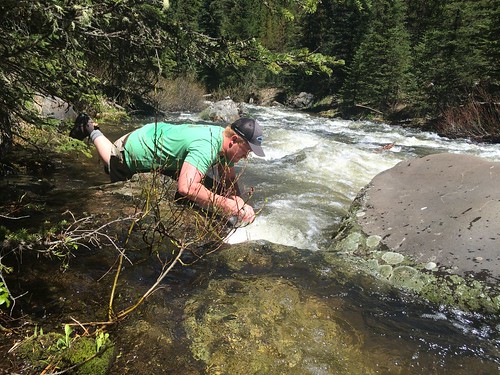
Citizen scientist volunteer Kenny Moore collects a water sample from one of over 60 project sites. All volunteers are trained to follow the collection requirements that ensure their samples can be accurately analyzed in the lab. They also visit the same site four times a year even in winter. Photo credit: Leanne Veldhuis
What do adventurers, microplastics, and your national forests have in common?
Water.
Our national forests and the glaciers, lakes, and rivers running through them form the headwaters for the majority of America’s drinking water. This includes many of our big cities and growing urban centers, even those that are far away from national forests. Because of its importance, protecting clean, abundant water is a priority for the U.S. Forest Service, and thankfully, it’s a priority of a growing number of our partners.
Adventurers and Scientists for Conservation is a nonprofit organization of folks who combine their skills as elite outdoors recreationists with a passion for science and monitoring and stewardship. They are leading a study of microplastics, which are synthetic fibers that are in many common products like clothing, face washes and toothpaste, and have been found in the Gallatin River, primarily within theCuster-Gallatin National Forest and connects through Bozeman, Montana, and Yellowstone National Park.
Microplastics are really good at absorbing chemical contaminants like DDT, PCBs and other chemicals. As microplastics float along in a river, they spread these pollutants across the environment, or may deposit themselves in the sediment of waterways. Similarly, a small piece of plastic also looks like food to fish, which then becomes a part of the human food chain.
With this project, Adventurers and Scientists leaders train volunteers in a multi-year citizen science effort. The citizen scientists then collect research-grade water samples from dozens of sites across the Custer-Gallatin, and send them to research scientist Abby Barrows in her lab in Stonington, Maine to detect the presence of any microplastics.
Anyone who is interested and has the skills to access the sometimes remote forest sites can volunteer to be a citizen scientist.
I hiked into the Montana wilderness with several citizen scientists, and learned that not only is plastic being found in the middle of the ocean, but microplastics have been found in 71 percent of the samples on the Custer-Gallatin – even those deep in the secluded, backcountry areas of the Gallatin portion of the forest where there is very little human activity.
The Forest Service’s land management activities include a focus on enhancing clean water, and encouraging conservation education and involvement in citizen science. But the agency cannot manage those activities off of the forest that end up harming our forests’ health.
The Forest Service looks forward to partnering with more groups like Adventurers and Scientists, and most importantly partnering with individuals like you to help sustain our natural resources for the greatest good.

Citizen scientist volunteer Sydney Parkhill checks the water temperature at a sample site. Environmental factors like temperature can help researchers compare data from different times of year, to provide clues for how microplastics persist in our river systems. Photo credit: Leanne Veldhuis
No comments:
Post a Comment
Note: Only a member of this blog may post a comment.